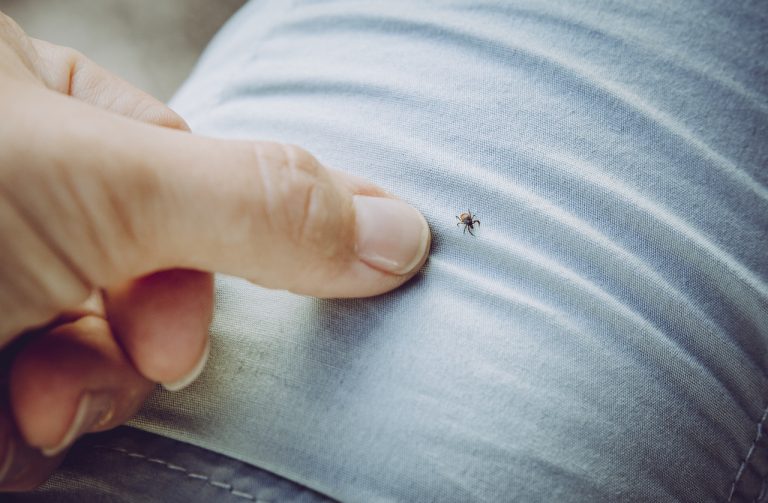Story Highlights
- A new Lyme disease vaccine candidate approved by the FDA using the fast track process is currently in its second phase of clinical trials.
- In 1998, the FDA granted licensure for a Lyme disease vaccine called LYMErix.
- Following reports of severe adverse reactions to LYMErix, GlaxoSmithKline (formerly SmithKline Beecham) withdrew the vaccine from the market in 2002.
Lyme disease is an infection caused by a bacterium known as Borrelia burgdorferi and is transmitted to humans through infected ticks. Typical symptoms include fever, headaches, fatigue and a characteristic skin rash called erythema migrans. In 2017, there were a total of 42,743 confirmed and probable cases of Lyme disease reported to the Centers for Disease Control and Prevention (CDC)—an increase of more than 17 percent since 2016.1 2
There are currently no vaccines for Lyme disease available for humans in the United States. However, there is a new vaccine candidate in the pipeline now in clinical trials.
In 2017, the U.S. Food and Drug Administration (FDA) approved a Fast Track designation for a new Lyme disease vaccine. The goal of the Fast Track designation is to get the vaccine on the market as soon as possible by lowering the bar for proof of safety and efficacy in favor of speeding up the licensing process. When an experimental is designated by the FDA for Fast Track approval, the FDA will accept less data from the manufacturer pre-licensure and allow ongoing post-marketing clinical studies after licensure approval.3 4 5
French biotech company Valneva has announced the initiation of the second study of Phase 2 clinical development for its Lyme disease vaccine candidate, VLA15. VLA15 is a multivalent, protein subunit vaccine that targets the outer surface protein A (OspA) of Borrelia. The goal of Phase 2 is to determine the optimal dosage level and vaccination schedule for its use in Phase 3 efficacy studies.5 6
The Phase 2 study is a randomized, observer-blind, placebo controlled trial conducted at sites in the U.S. where Lyme disease is endemic. Plans call for 250 people to receive one of two doses of VLA15 (100 people each) or placebo (50 people). The vaccine candidate contains aluminum adjuvants and will be injected intramuscularly at day 1, day 57 and day 180. The participants in the study will be monitored for 18 months immunogenicity will be measured at day 208. The clinical trial participants will include healthy adults between the ages of 18 and 65.5
The LYMErix Debacle
VLA15 is not the first Lyme disease vaccine to be developed. In December 1998, the FDA approved a recombinant Lyme disease vaccine known as LYMErix that was manufactured by SmithKline Beecham (now GlaxoSmithKline). LYMErix was a three-dose vaccine that was believed to be 49 to 68 percent effective at preventing Lyme disease with two doses and 76 to 92 percent effective after the third dose.6 7
As a result of concerns regarding the potential safety of the vaccine prior to its licensure, an FDA panel met in May 1998 to review the proposed LYMErix vaccine. The panel acknowledged that there were several safety concerns regarding the vaccine, one of which was its possible relationship to autoimmune arthritis. The panel was concerned that the vaccine could result in inflammatory arthritis in genetically susceptible patients. This concern was raised during a clinical study in which vaccine subjects reported a greater number of transient arthralgias than the placebo subjects. Despite the glaring concerns, the FDA panel gave its unanimous support for the vaccine’s licensure.7 8
Soon after the vaccine was licensed in the U.S, there was a burst of media coverage around Lyme disease and LYMErix. The vaccine received prime time media coverage, with news reports highlighting the benefits of the vaccine but with almost no mention of the potential risks associated with the vaccine. The media encouraged those living in endemic areas to consult their health professionals about getting the vaccine.8 9
By 1999, LYMErix was receiving more negative than positive publicity. There were reports of serious adverse reactions occurring after vaccination. Although there was a wide range of adverse reactions reported, musculoskeletal complaints such as arthritis were the most common in these reports. The media began reporting experiences of vaccine injured victims and the Lyme Disease Network, a non-profit citizen action group, had extensive website coverage about serious reactions to LYMErix.8
In December 1999, the Philadelphia law firm of Sheller, Ludwig & Bailey filed a class action lawsuit against the LYMErix™ manufacturer, SmithKline Beecham. The law firm represented 121 individuals who claimed that they experienced severe adverse reactions to LYMErix. The suit claimed that the vaccine caused harm and that the manufacturer deliberately concealed evidence about its risks and failures.8
As a result of lawsuits and public outcry at a Jan. 31, 2001 meeting of the FDA Vaccines & Related Biological Products Advisory Committee (VRBPAC), the committee discussed evidence for safety concerns about LYMErix and held a two-hour public comment session. Participants at the meeting included FDA scientific advisors, representatives from SmithKline Beecham, physicians, consumer advocacy organizations, vaccine injured victims and their lawyers.8 10
The FDA advisory committee reviewed a summary of the Vaccine Adverse Event Reporting System (VAERS) data and concluded that there was no causal relationship between LYMErix and inflammatory arthritis. SmithKline Beecham assured the panel that LYMErix was safe and provided a status review of their Phase 4 post-marketing surveillance. Physicians spoke about the effectiveness of the vaccine, noting a dramatic decline of Lyme disease in their clinical practices.8
There were other scientists at the meeting, however, who argued that the vaccine could indeed trigger OspA-autoimmunity in those patients who had a genetic susceptibility. Vaccine injured victims described their suffering and their lawyers said that the manufacturer deliberately failed to provide warnings about increased reaction risks for genetically susceptible patients.8
The FDA Committee, however, decided that the benefits of LYMErix outweighed its risks. No changes were made to the product’s labeling or indications. The FDA requested that the manufacturer provide more vaccine and efficacy data by increasing the number of subjects in the Phase 4 post-marketing trial. The vaccine remained on the market for public use.8
Due to the negative press coverage and publicity about the vaccine risks and lawsuits, the sales for LYMErix dropped significantly. In 2001, the manufacturer reported $5 million in sales with the purchase of only 93,000 doses of the vaccine. In February 2002, GlaxoSmithKline (GSK) decided to withdraw the vaccine from the market citing poor market performance.7 8
In July 2003, GSK settled the class action lawsuit with Sheller, Ludwig & Bailey and other smaller law firms. The agreement included $1 million for legal fees for the prosecuting attorneys but no compensation for the vaccine injured victims. The prosecuting attorneys expressed that the voluntary withdrawal of the vaccine from the market was the main intention of the lawsuit.8
According to a report published in Epidemiology & Infection: “Despite the settlement, the manufacturer continued to deny that LYMErix™ caused harm and indicated that the decision to settle represented a choice based on economic concerns (i.e. the desire to avoid the costs of lengthy litigation) for a product showing relatively poor performance in the market.”8
References:
1 Centers for Disease Control and Prevention. Lyme Disease: Recent Surveillance Data. CDC.gov Dec. 21, 2018.
2 CDC. Lyme Disease. CDC.gov June 3, 2019.
3 Holland K. How Close Are We to Getting a Lyme Disease Vaccine? Healthline June 6, 2019.
4 Raines K. Experimental Drugs and Vaccines on FDA’s Fast Track. The Vaccine Reaction Jan. 17, 2019.
5 Firger J. Lyme Disease Vaccine on Fast Track for FDA Approval. Newsweek July 25. 2017.
6 Valneva. Valneva Initiates Second Phase 2 Study for its Lyme Disease Vaccine Candidate VLA15. Globe News WireJuly 1, 2019.
7 National Institute of Allergy and Infectious Diseases. Lyme Disease Vaccines. NAID.NIH.gov Nov. 16, 2018.
8 Poland G. Vaccines against Lyme Disease: What Happened and What Lessons Can We Learn? Clinical Infectious Diseases 2011; 52(suppl. 3): 253-258
9 Nigrovic LE, Thompson KM. The Lyme Vaccine: A Cautionary Tale. Epidemiology & Infection 2007; 135(1): 1-8.
10 Smith P. Special Report: Lyme Disease Association Meets with FDA on LYMErix. Jan. 22, 2002.













8 Responses
“Due to the negative press coverage and publicity about the vaccine risks and lawsuits, the sales for LYMErix dropped significantly.”
And this would explain the current censorship regarding the safety and efficacy of vaccines. Can’t have this happening again. Seems no one cares about those being injured. And many that I talk to just don’t want to know. Sad and disgusting.
Lyme is a “soup” of various infections, not just Borrelia burgdorferi. That is why it’s so dang hard to eliminate. Even if they come up with a vaccine to counter the borrelia, there’s plenty more waiting in the wings to deal with. The only success I had with over-coming Lyme was with herbs and certain nutritional protocols. A vaccine is only adding to the toxic burden already present from the various infections.
This. Right here. It adds to toxic burden and doesn’t really help. Detoxing from environmental toxins is one of the keys to getting over Lyme disease. And autoimmune is, in my opinion, even worse than Lyme because you can’t get rid of it after killing the bacteria and detoxing. It’s the body attacking itself and usually lasts for the rest of the person’s life.
But, but, but are you really telling us that not all vaccines are 100% safe and 100% effective like our doctors, Big Pharma, the media, and the politicians keep telling us as they gradually force us and our children to be injected with a wide variety of toxins “for the public good?” Nah, go on, say it ain’t so…
As someone else stated, what we’re currently defining as “Lyme disease” can come from strains besides Borrelia Bergdorferi. Maybe someday we’ll have things more sorted out and be able to determine different names for the different bacterial strains of the illness to make things more clear. Until then, trying to fix Lyme by treating Borr. Berg. alone is kind of pointless for individuals who have Lyme from a different bacteria.
Further, I had one Lyme practitioner tell me that he estimated 70% of persons here in Wisconsin have Lyme, with symptoms ranging from none to wheelchair-bound and on a respirator. He said that Lyme is not just tick-transmitted, but sexually-transmitted, mosquito-transmitted, and may be passed from mother to child. If this all is indeed the case, instead of trying to obliterate a particular bacteria that we are not unlikely to be exposed to in our lives and which only some of us are even having a problem with, maybe we should be trying to figure out why some of us are tolerating the bacteria colonizing us and some of us are not? And perhaps (as ALWAYS) we should be focusing on how to work with the body and build up the immune system to fight its own battles against these diseases, instead of trying to artificially force the activation of the immune system in a way that produces a superficial “immunity” at best.
Otzi the iceman from 3300 BCE was found to have Borr. Berg. This bacteria isn’t new. Why is it only causing so many of us such trouble now?
But this method of addressing the problem is not profitable.
Fast Track “…by lowering the bar for proof of safety and efficacy”. Someone please tell me how the bar can get any lower?
And as for a Lyme vaccine, there is already a way to prevent Lyme and its various coinfections. It’s a homeopathic remedy called “Lyme nosode”, and it’s quite effective. Nothing is 100%, but the nosode is extremely safe (as all homeopathic remedies are) as well as effective. Effectiveness is not measured in titers (antibody levels) but in whether the body remains resistant. So far, none of my animals (horses, dogs, goats) or my family has contracted Lyme and we are constantly pulling ticks off.
Place 4 data was never publicly released.